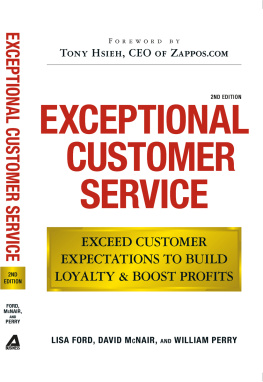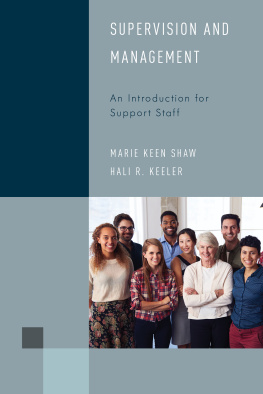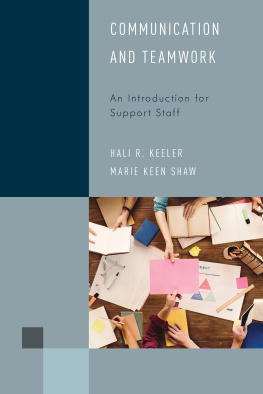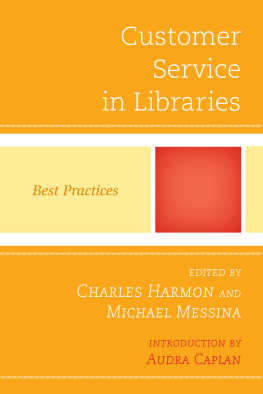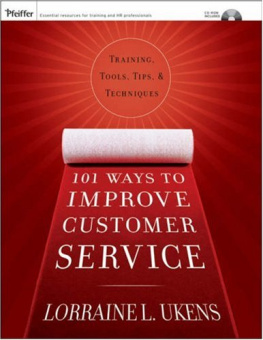Stellar Customer Service

Training Library Staff to Exceed Expectations

Mou Chakraborty, Editor

Copyright 2016 by Mou Chakraborty
All rights reserved. No part of this publication may be reproduced, stored in a retrieval system, or transmitted, in any form or by any means, electronic, mechanical, photocopying, recording, or otherwise, except for the inclusion of brief quotations in a review, without prior permission in writing from the publisher.
Library of Congress Cataloging-in-Publication Data
Names: Chakraborty, Mou, editor.
Title: Stellar customer service : training library staff to exceed expectations / Mou Chakraborty, editor.
Description: Santa Barbara, CA : Libraries Unlimited, [2016] | Includes bibliographical references and index.
Identifiers: LCCN 2016029396 (print) | LCCN 2016032890 (ebook) | ISBN 9781440840760 (pbk) | ISBN 9781440840777 (eBook)
Subjects: LCSH: Public services (Libraries)United States. | LibrariesCustomer servicesUnited States. | Library employeesIn-service trainingUnited States.
Classification: LCC Z711. S793 2016 (print) | LCC Z711. (ebook) | DDC 020.71/55dc23
LC record available at https://lccn.loc.gov/2016029396
ISBN: 978-1-4408-4076-0
EISBN: 978-1-4408-4077-7
20 19 18 17 16 1 2 3 4 5
This book is also available as an eBook.
Libraries Unlimited
An Imprint of ABC-CLIO, LLC
ABC-CLIO, LLC
130 Cremona Drive, P.O. Box 1911
Santa Barbara, California 93116-1911
www.abc-clio.com
This book is printed on acid-free paper 
Manufactured in the United States of America
Contents
Mou Chakraborty
Alice Bahr
Karen Glover
Cheryl McGrath and Paul Bellenoit
Jordan Jefferson and Mike VanderHeijden
Sarah Hammill
Laurie Willhalm
Anne Marie Casey and Kathleen Citro
Valerie S. Gordon and Lee Vucovich
Lois Albertson and Jeannette Smithee
Andrea Cecchetto
Jennifer Laredo, Melissa Maglio, and Heidi Murphy
Sue Kaler
Donna J. McCloskey
Lewis Belfont
Mou Chakraborty
Introduction
Mou Chakraborty
Libraries are facing unprecedented challenges from a wide variety of obstacles like shrinking budgets, shifting user demographics, physical space-related issues, diversified collections, and most importantly continuous upkeep with evolving technologies. Libraries are in competition with a myriad of easily accessible alternative information resources led by Google from the front. The only constant in this ever-evolving sea of changes is the human touch and the willingness to serve customers (or users, patronswhatever we decide to call them) well. This inspiring need and the spontaneity to serve an astonishing range of customers sets a library apart from all its machine-hearted competitors. Customers are growing technologically savvy to seek information from other sources (Google has turned into a default first stop and more than often the last stop without even thinking of the information world outside Google). Acclaimed author Neil Gaiman sums this up in this widely used noteworthy tidbit:
Google can bring you back 100,000 answers. A librarian can bring you back the right one.
In their excellent book, Peter Hernon and Joseph Mathews (2011) draw attention to an OCLC report stating that it has been challenging for the libraries to create their brand in the competitive information environment (p. 12).
Historically, libraries were created with service to people in mind. The librarians and library staff are passionate, dedicated and take pride in serving people. Hernon and Mathews (2011) reaffirm that libraries are still service organizations (p. 8). So a strong, flowing customer service ethics should be a no-brainer! Then why is there so much discussion on customer service training? The listservs are abuzz with issues in staff training, student training, training techniques, and assessment of trainings just to name few. A variety of challenges mentioned earlier surrounding the library landscape ensure that libraries come up with stellar service leading by example; growing competition is forcing libraries to re-evaluate their services and embrace positive changes while being mindful of providing excellent customer service. Pew Research Centers Internet & American Life Project (2013) survey found that while library users want digital service to expand, they still want to hold on to print books. OCLC in its Library Customer Service Overview nails it down:
As our profession contemplates the future of libraries, a recurring theme surfaces: that the public trust and faith in the institution is not so much about information retrieval or document management as it is about the intangiblesthe relationships, the place, the environment for learning. It is top-notch customer service that will sustain and grow libraries.
This edited volume was conceived with the idea that customer service is customer service across a wide spectrum of libraries. However, depending on the size and the type of library, staff training may differ. Many libraries are brainstorming interesting and innovative ideas with their training programs. On listservs, interest regarding different aspects of training and requests for sharing information, is gaining significant momentum. This led me into thinking: why not have contributors from a variety of library typesacademic libraries (different sizes), public libraries, medical libraries, special libraries, law libraries, and joint-use libraries? The focus will be on staff training programs/initiatives for public services staff (including professional staff, paraprofessional staff, and student workers) providing customer service. While there may be a chapter on the pedagogical aspects of customer service, most chapters will offer practical advice and creative solutions for staff working on customer service issues, providing them with the improved, innovative skills and tools that help them interact better with customers professionally and effectively.
The book sets out to do exactly as planned: authors tell their stories of staff training at their respective libraries, offering practical tips, pointing out challenges, and sharing materials whenever possible. process. She proposes job shadowing so that people from all departments appreciate each others job responsibilities and understand that they are all working toward the same goalin relentless pursuit of perfecting customer satisfaction. They are all contributing to an organizations whole effort and not working in silos executing a set of discrete steps.
Exemplary customer service cannot operate in a vacuum; a detailed comprehensive training plan is critical. In the chapter Creating a Comprehensive Training Plan for Better Customer Service Experiences in Your Library, Karen Glover details the process of creating a comprehensive training plan, key factors to consider when creating such plan, guidelines for successful implementation, and steps for plan improvement with the ultimate goal of enhancing customer service experiences. The chapter discusses assessing training needs, determining key training elements, gathering resources, and creating a detailed training schedule. The next steps include job shadowing, follow-up training sessions, and most importantly, program assessment.
Next page

